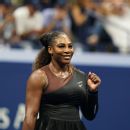Defending champion Rafael Nadal is back in the US Open quarterfinals, in which he will face Dominic Thiem. Joining them in the quarters is John Isner, who used a booming serve to defeat Milos Raonic in five sets.
Set 1 was nothing like Set 2, and Set 3 was a completely different story. This is how Serena Williams beat Kaia Kanepi at the US Open.
Down the stretch they come. Who will win, who will flop? Our intrepid crew on the grounds unveils its Week 2 predictions.
2 Related
The short answer is Juan Martin del Potro , whom Isner will meet in the quarterfinals. Del Potro, the 2009 US Open champion, is a career-high No. 3 in the world, and also a sentimental favorite after coming back from a protracted series of wrist surgeries.
The long answer is, “Indeed, why not?”
Isner, the 6-foot-10 North Carolingian who hit a career-high ranking of No. 8 in late July, is living the best days of his tennis life. And it’s not that long after he endured some of the bleakest. He started the year winning just one match in six tournaments and found himself in danger of falling out of the top 20. He was newly married but fast closing on the age of 33, tying himself in knots about his tennis future.
Then in a dramatic turnaround, Isner won the biggest title of his life, the Miami Masters 1000. He attributed the feat mainly to a series of heart-to-heart conversations with his coach, Macpherson. (Isner describes him as “the most underrated guy in tennis.”) He convinced Isner to start untying some of those internal knots, free up his arm and wean himself off over-reliance on his serve.
“In the past, I’ve played where I only just rely on my serve,” Isner said, after dismissing Raonic the hard way, without relying on his serve to carry him through a single tiebreaker. “But I think more times than not this year I’ve shown some other ability. That comes from just being relaxed on the court. It’s not a product of more reps and more practice. The mental part of the game, being able to free up on the tennis court is much easier said than done.”
Macpherson, who is also the longtime coach of uber-successful doubles team Bob and Mike Bryan , told ESPN.com: “The most critical reason for how well John is playing is that he’s gotten some peace and clarity. He’s taken some of the mental pressure off.”
John Isner has reached the quarterfinals in back-to-back majors for the first time in his career. Danielle Parhizkaran/USA TODAY SPORTS
Isner’s state of calm is also a product of the stability in his life. Isner’s wife, Madison, is due to give birth to the couple’s first child in late September. The couple have started their independent life in Dallas.
Nicolas Mahut , with whom Isner has a bond ever since the men played the longest tennis match in history in 2010, is also a father.
“For sure a baby is changing a man,” Mahut told ESPN.com. “When I talked with John in the locker room, I see he looks happy with his life, and he has confidence in his tennis. I am so happy for him that he reached the quarterfinals again. I believe he can make it still go further.”
Mahut believes Isner is a more consistent player now, stronger from the baseline and more competent as a returner.
Macpherson and Justin Gimelstob , a Tennis Channel analyst who moonlights as Isner’s co-coach when time allows, determined that Isner’s return game needed to be not only more consistent but, in Macpherson’s words, “dyamic and destructive.” They weren’t looking for miracles, just a much more aggressive and effective reply, particularly to second serves. Return with greater intent and you have a better chance to wrest control of the ensuing rally.
Isner continued sanding the edges on some aspects of his game in the months following Miami, enjoying reasonable success on clay. Then he punched through with the best Grand Slam result of his career by reaching the semifinals at Wimbledon. He lost to Kevin Anderson in yet another grass-court death march, capitulating 26-24 in the fifth set.
play
0:35
Milos Raonic sends the ball into the net, and John Isner wins the five-set match 3-6, 6-3, 6-4, 3-6, 6-2.
Isner bounced back nicely from that blow. He won at Atlanta for the fifth time in six years, showing a general consistency that at other times in his career had proved elusive.
“It’s been flowing naturally since Miami,” Isner said. “After Wimbledon, that was very tough. I was beat up mentally and physically from that match, but it was still a very encouraging result.”
Isner’s serve and forehand are his money shots, but he has surprisingly quick — and soft — hands that enable him to excel at net. He will need a full complement of tools if he’s going to effectively challenge del Potro, against whom Isner is 4-7. They split their most recent matches. Isner beat him in Miami, while del Potro retaliated a few weeks later on a slow, damp clay court at the French Open.
“He was a little bit gassed in that [Miami] match,” Isner said of his upcoming opponent. “Now he’ll have a full tank of energy. It will be a very tough ask.”
Gimelstob, among others, is optimistic. He pointed to the variety and skill set Isner brought to the match with Raonic. “There were a lot of pure skill shots,” Gimelstob said. “Lots of breaks, opportunities, transitional play, drop volleys, aggressive groundstrokes. John’s skills are super impressive when he’s relaxed, and since he’s been relaxed he’s cleaned up and improved some of his shots.”
Expectations might be rising, but Isner is clinging to his new frame of mind. “I don’t feel that pressure,” he said. “I think maybe four or five years ago I may have felt that. But right now I don’t.”
Pressure-free, Grand Slam-winning tennis. Why not John?
Powered by WPeMatico



